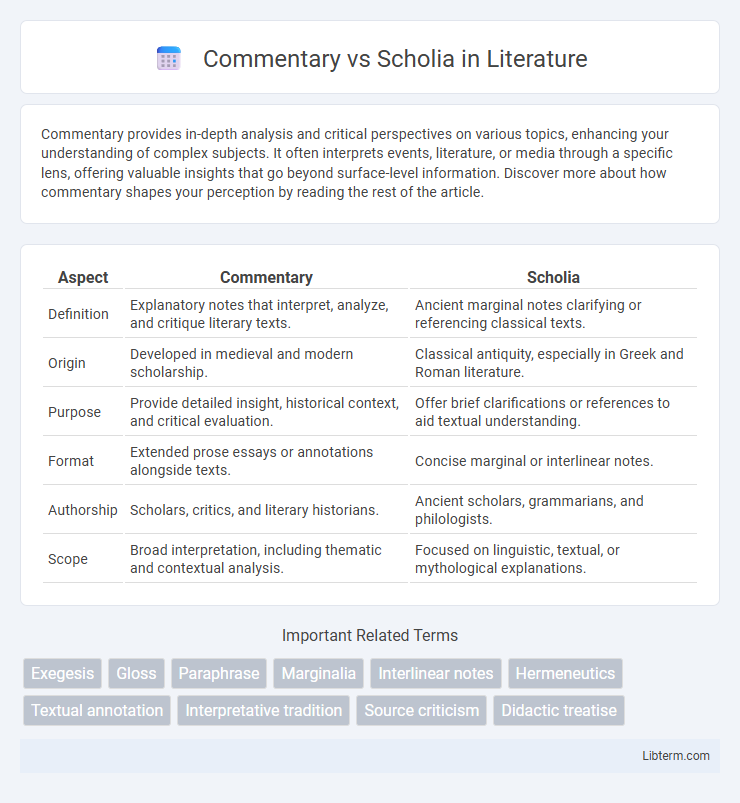Commentary provides in-depth analysis and critical perspectives on various topics, enhancing your understanding of complex subjects. It often interprets events, literature, or media through a specific lens, offering valuable insights that go beyond surface-level information. Discover more about how commentary shapes your perception by reading the rest of the article.
Table of Comparison
| Aspect | Commentary | Scholia |
|---|---|---|
| Definition | Explanatory notes that interpret, analyze, and critique literary texts. | Ancient marginal notes clarifying or referencing classical texts. |
| Origin | Developed in medieval and modern scholarship. | Classical antiquity, especially in Greek and Roman literature. |
| Purpose | Provide detailed insight, historical context, and critical evaluation. | Offer brief clarifications or references to aid textual understanding. |
| Format | Extended prose essays or annotations alongside texts. | Concise marginal or interlinear notes. |
| Authorship | Scholars, critics, and literary historians. | Ancient scholars, grammarians, and philologists. |
| Scope | Broad interpretation, including thematic and contextual analysis. | Focused on linguistic, textual, or mythological explanations. |
Understanding Commentary and Scholia
Commentary and scholia serve as essential tools for interpreting classical texts, with commentary providing detailed explanations and critical analysis by scholars to clarify meanings and contexts. Scholia are ancient marginal notes or annotations directly written on manuscripts, offering interpretative insights or linguistic clarifications from early commentators. Understanding the distinction enhances the study of classical literature by revealing how ancient and modern perspectives contribute to textual comprehension.
Historical Origins of Commentary and Scholia
Commentary and scholia both originated in ancient scholarly traditions, with commentary emerging prominently in classical Greece and Rome as detailed explanations and interpretations of literary or legal texts. Scholia began as marginal notes or interlinear glosses added by ancient scholars to manuscripts, primarily during the Hellenistic period, to clarify difficult passages or provide brief critical remarks. While commentaries evolved into extensive prose analyses authored by individual scholars, scholia remained concise annotations integrated into manuscript margins, reflecting distinct historical functions in textual scholarship.
Key Differences Between Commentary and Scholia
Commentary provides an extensive, detailed explanation and interpretation of a text, often written by a single scholar, while scholia are brief marginal notes or annotations offering concise clarifications or commentary typically by various ancient or medieval scholars. Commentaries tend to cover the entire text systematically, whereas scholia highlight specific words, phrases, or passages to elucidate linguistic, historical, or literary aspects. The key difference lies in the scope and depth: commentary aims for comprehensive analysis, whereas scholia serve as succinct interpretative remarks supplementing the main text.
Purpose and Function in Textual Analysis
Commentary serves to provide comprehensive explanations, interpretations, and critical analysis of a primary text, aiding readers in understanding complex ideas and contexts. Scholia consist of brief marginal notes or annotations that clarify specific words, phrases, or passages, offering concise insights or alternate readings. While commentary aims for in-depth exploration and scholarly discussion, scholia focus on immediate textual clarification and support for close reading.
Structural Features: Commentary vs Scholia
Commentaries typically present extensive, line-by-line explanations with a structured, detailed approach organized into chapters or sections, facilitating in-depth analysis of primary texts. Scholia, by contrast, consist of brief marginal notes or annotations that highlight specific points or clarify difficult passages without extensive elaboration. The structural distinction lies in commentaries' comprehensive format versus scholia's concise, fragmentary nature, reflecting their different roles in textual interpretation.
Notable Examples in History
Notable examples of commentary include Thomas Aquinas's "Summa Theologica," which systematically interprets Christian theology, and Rashi's comprehensive commentaries on the Hebrew Bible and Talmud, pivotal in Jewish scholarship. Scholia are exemplified by the ancient Greek scholia on Homer's epics, which provide marginal notes explaining linguistic, mythological, and historical contexts, preserved in manuscripts from Alexandria. Both forms of exegesis enhance understanding but differ in scope: commentaries offer extensive, standalone analysis, while scholia provide concise, explanatory annotations linked to specific text passages.
Influence on Literary Interpretation
Commentary and scholia both shape literary interpretation by providing critical insights and contextual information that deepen understanding of texts. Commentaries tend to offer structured, in-depth analyses that explore themes, historical background, and authorial intent, influencing how readers perceive narrative and symbolism. Scholia, often concise marginal notes originating in ancient manuscripts, deliver immediate explanatory remarks that clarify language or references, directly impacting textual comprehension and interpretive strategies.
Modern Applications and Relevance
Commentary provides detailed explanations and interpretations of texts, often integrating historical context and authorial intent, enhancing modern academic research and legal analysis. Scholia offer concise marginal notes or annotations that clarify specific passages, proving valuable in digital humanities and classical studies through searchable databases and textual comparisons. Both tools assist in critical editions and scholarly communication, fostering deeper understanding and accessibility of complex materials in contemporary education and research.
Challenges in Distinguishing Commentary and Scholia
Distinguishing commentary from scholia is challenging due to their overlapping functions in interpreting classical texts and historical manuscripts. Commentaries typically provide extensive, structured analysis and explanation by a single author, whereas scholia are often marginal notes or brief glosses by various scholars across different periods. The fluidity in form, purpose, and attribution complicates semantic categorization and digital indexing in philological research.
Summary: Choosing Between Commentary and Scholia
Choosing between commentary and scholia depends on the depth of analysis and context required; commentary offers detailed explanations, interpretations, and critical insights, ideal for comprehensive understanding, while scholia provide concise annotations or marginal notes that clarify specific points or references. Scholars seeking thorough engagement with a text prefer commentary for its expansive scholarly discourse, whereas those needing quick clarifications or textual variants often rely on scholia. The decision hinges on balancing the need for exhaustive exegesis against the efficiency of succinct summarization.
Commentary Infographic

 libterm.com
libterm.com